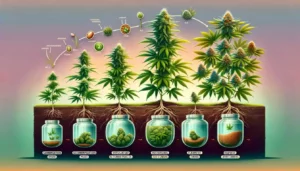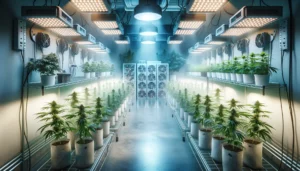This comprehensive guide serves to navigate the complex legal landscape of cannabis cultivation laws across the United States. We delve into a state-by-state analysis of regulations, providing an easy-to-understand breakdown for indoor growers. Whether you’re a novice or a seasoned grower, our guide will shed light on the legalities you need to be aware of, ensuring your cultivation practices are lawful and safe.
Understanding the Federal Law: Where Does Cannabis Stand?
Cannabis cultivation laws in the United States are complex and ever-changing, with the federal government holding a significant influence over the legal landscape. At the federal level, cannabis is still classified as a Schedule I controlled substance, meaning it is deemed to have a high potential for abuse and no accepted medical use. This classification has led to a conflict between state and federal laws regarding cannabis cultivation.
However, in recent years, there has been a shift in federal policy towards cannabis. Several states have legalized cannabis for medical and/or recreational use, leading to a patchwork of laws across the country. The federal government has taken a hands-off approach, allowing states to regulate cannabis within their borders as long as they enforce certain guidelines, such as preventing distribution to minors and ensuring public safety.
Despite this shift, it is important to note that cannabis cultivation remains illegal under federal law. This means that even in states where cannabis cultivation is legal, growers may still face potential legal consequences at the federal level. It is crucial for indoor growers to be aware of the potential risks and navigate the legal landscape accordingly.
To stay compliant with federal law, it is important to be knowledgeable about the specific laws and regulations in your state or region. Understanding the federal law can help you make informed decisions when it comes to cannabis cultivation, ensuring that you are operating within the boundaries of the law.
A Closer Look at the West Coast: What’s the Verdict on Cannabis Cultivation?
The West Coast of the United States has been at the forefront of cannabis legalization, with several states paving the way for the cultivation of cannabis indoors. Let’s take a closer look at the current state of cannabis cultivation laws on the West Coast.
- 1. California:
California has long been associated with cannabis cultivation, and in 2016, it legalized the recreational use and cultivation of cannabis for adults 21 and older. This means that individuals can legally grow up to six plants for personal use indoors. However, there are restrictions on the size of the grow space and the amount of cannabis that can be harvested and possessed. - 2. Oregon:
In Oregon, both medical and recreational cannabis cultivation is legal. Adults 21 and older can grow up to four plants per household for personal use indoors. However, there are limitations on the number of plants that can be grown and the amount of cannabis that can be possessed. Additionally, individuals must obtain a license from the Oregon Liquor Control Commission to legally grow cannabis for commercial purposes. - 3. Washington:
Washington was one of the first states to legalize recreational cannabis, but it has more restrictive laws when it comes to cultivation. While adults 21 and older can legally possess and use cannabis, they cannot grow it for personal use. Only licensed producers can cultivate cannabis for commercial purposes in the state.
Navigating the Midwest: Are We Seeing a Green Revolution?
The Midwest region of the United States has traditionally had more conservative views on cannabis, but in recent years, there has been a noticeable shift toward legalization and acceptance of cannabis cultivation. Let’s explore the current state of cannabis cultivation laws in the Midwest and whether we are witnessing a green revolution in this region.
- 1. Illinois:
Illinois made headlines in 2020 when it became the first state in the Midwest to legalize recreational cannabis. Adults 21 and older can legally grow up to five plants for personal use indoors. However, there are restrictions on the number of plants that can be cultivated and the amount of cannabis that can be possessed. Commercial cultivation requires a license from the state. - 2. Michigan:
Michigan also legalized recreational cannabis in 2018, allowing adults 21 and older to grow up to 12 plants for personal use indoors. However, there are limitations on the number of plants that can be grown and the amount of cannabis that can be possessed. Commercial cultivation requires a license from the state. - 3. Ohio:
While Ohio has not yet legalized recreational cannabis, it has a medical cannabis program in place. Registered patients and caregivers can cultivate up to 12 plants for personal use indoors, but there are strict regulations and licensing requirements to ensure compliance. - 4. Minnesota:
Minnesota has a limited medical cannabis program that allows registered patients to use and possess cannabis for medical purposes. However, there are no provisions for personal cultivation, and all cannabis products must be obtained from state-licensed dispensaries.
“The South: A Tough Nut to Crack?”
The South has traditionally been known for its conservative stance on cannabis, making it a challenging region for cannabis cultivation. However, there have been some notable developments in recent years that indicate a shift towards more lenient cannabis laws.
- 1. Florida:
Florida legalized medical cannabis in 2016, allowing registered patients to use and possess cannabis for medical purposes. However, personal cultivation is not permitted, and all cannabis products must be obtained from state-licensed dispensaries. - 2. Louisiana:
Louisiana has a medical cannabis program that allows registered patients to use and possess cannabis for medical purposes. However, personal cultivation is prohibited, and all cannabis products must be obtained from state-licensed dispensaries. The program is relatively limited in terms of qualifying conditions and available products. - 3. Virginia:
Virginia made history in 2021 when it became the first Southern state to legalize recreational cannabis for adults 21 and older. However, the law does not permit personal cultivation, and commercial cultivation is heavily regulated and requires a license from the state.
The Northeast: A Beacon of Legalization?
The Northeast region of the United States has emerged as a beacon of cannabis legalization, with several states leading the way in terms of progressive cannabis cultivation laws.
- 1. Massachusetts:
Massachusetts legalized recreational cannabis in 2016, allowing adults 21 and older to possess and cultivate a limited number of cannabis plants for personal use. The state also has a well-regulated medical cannabis program, providing opportunities for both personal and commercial cultivation. - 2. Maine:
Maine also legalized recreational cannabis in 2016, allowing adults 21 and older to possess and cultivate a limited number of cannabis plants for personal use. The state has established regulations for commercial cannabis cultivation, offering opportunities for licensed growers. - 3. Vermont:
Vermont legalized recreational cannabis in 2018, allowing adults 21 and older to possess and cultivate a limited number of cannabis plants for personal use. However, the state does not have a commercial cannabis market, limiting opportunities for large-scale cultivation. - 4. New York:
New York joined the ranks of legal cannabis states in 2021, legalizing recreational cannabis for adults 21 and older. The law allows personal cultivation of a limited number of cannabis plants and establishes a regulated commercial market for cannabis cultivation. - 5. Connecticut:
In 2021, Connecticut passed legislation to legalize recreational cannabis, allowing adults 21 and older to possess and cultivate a limited number of cannabis plants for personal use. The state is in the process of developing regulations for a commercial cannabis market, which will provide opportunities for licensed growers.
“Is Your Indoor Grow Space Legal? Know Your Rights”
As an indoor cannabis grower, it is essential to understand the legality of your grow space and be aware of your rights. Each state has its own regulations regarding the location and setup of indoor cannabis cultivation facilities.
First and foremost, check if your state requires a license or permit to operate an indoor grow space. Some states only allow licensed individuals or businesses to cultivate cannabis, while others may have specific requirements for personal cultivation. Familiarize yourself with the licensing process and ensure that you meet all the necessary criteria before starting your grow operation.
Next, consider the zoning regulations in your area. Many states have specific zoning laws that dictate where cannabis cultivation can take place. Ensure that your chosen location complies with these regulations to avoid any legal issues down the line. Additionally, be mindful of any restrictions on the proximity of your grow space to schools, public places, or residential areas.
It is also crucial to understand the security requirements for your indoor grow space. Many states have strict guidelines regarding security measures to prevent unauthorized access and theft. These requirements may include surveillance cameras, alarm systems, secure locks, and restricted access to the cultivation area. Complying with these regulations not only keeps your grow operation legal but also helps protect your investment.
Lastly, stay informed about any updates or changes in the cannabis cultivation laws in your state. Laws regarding cannabis cultivation can evolve over time, and it is your responsibility to stay up-to-date with any new regulations or requirements. This may involve regularly checking government websites, attending industry conferences, or consulting with legal professionals specializing in cannabis law.
“The Future of Cannabis Cultivation: What’s in Store?”
As the cannabis industry continues to expand and evolve, the future of cannabis cultivation holds exciting possibilities. Here are some key trends and advancements to keep an eye on:
- 1. Technological Innovations:
Advancements in technology are revolutionizing the way cannabis is grown indoors. From automated nutrient delivery systems to climate control technology, growers have access to tools that can optimize plant growth and increase yields. Additionally, the development of advanced lighting systems, such as LED technology, is providing more efficient and cost-effective options for indoor cultivation. As technology continues to advance, we can expect even more innovative solutions to enhance the efficiency and productivity of cannabis cultivation. - 2. Sustainable Practices:
As sustainability becomes a growing concern globally, the cannabis industry is also shifting towards more eco-friendly practices. Cultivators are exploring sustainable growing methods, such as organic farming, water conservation techniques, and renewable energy sources. By reducing environmental impact, growers can not only meet consumer demands for eco-conscious products but also minimize costs and improve long-term viability. - 3. Research and Genetic Advancements:
With the relaxation of cannabis laws in many regions, there has been a surge in scientific research focused on cannabis genetics and cultivation techniques. This research is leading to the development of new strains with specific characteristics and improved cultivation methods. Growers can expect access to a wider variety of strains tailored to specific consumer preferences, as well as a better understanding of optimal growing conditions for enhanced potency and yield.
The legalities surrounding cannabis cultivation vary widely from state to state, making it imperative for indoor growers to stay updated with the latest laws. As we strive for a more unified regulatory framework, it is important to always consult local ordinances and remain compliant. As the cannabis industry continues to evolve, so will its regulations. Therefore, make sure to keep abreast with the ever-changing legal landscape of cannabis cultivation.




